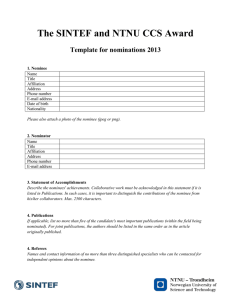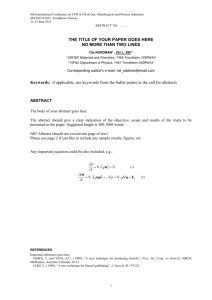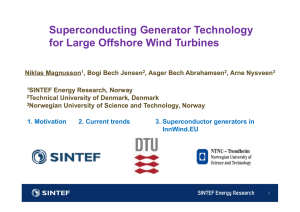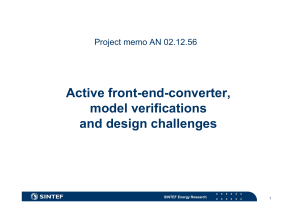SINTEF Energy Research
advertisement
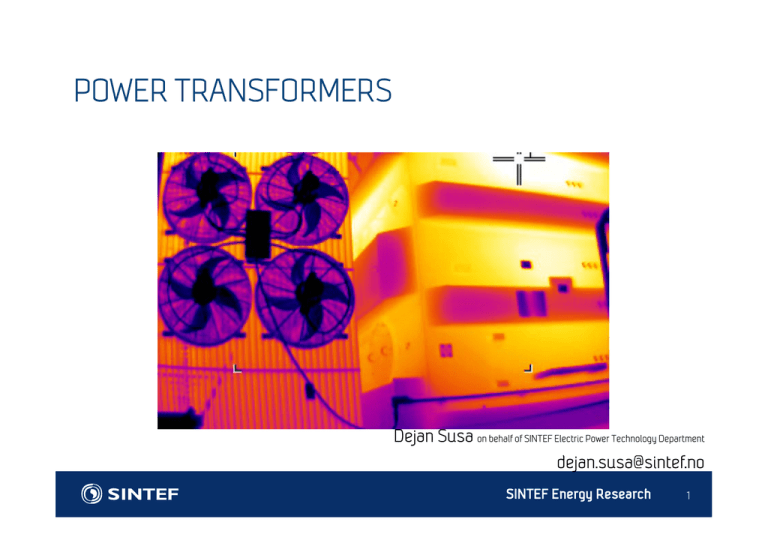
POWER TRANSFORMERS Dejan Susa on behalf of SINTEF Electric Power Technology Department dejan.susa@sintef.no SINTEF Energy Research 1 Transformer design • Insulation – Liquid, Air – Solid • Stresses – Thermal – Dielectric – Mechanical Electrical Breakdown SINTEF Energy Research 2 Insulation Degradation: Remaining lifetime 1 1 EA DPNOW DPEND Re mainingLife e RT A SINTEF Energy Research 3 Transformer Life Parameters Load Current Top-Oil Temp. Hot-Spot Temp. H2O Ambient Temp. DGA Bottom-Oil Temp. SINTEF Energy Research 4 Relative Position Characteristic Temperatures H x gr Top Oil Tank Hot-Spot Top Oil-Winding Cooler HV winding Average Winding LV winding Average Oil Core gr Bottom OilWinding Ambient Temperature rise SINTEF Energy Research 5 IEC 60076-2: Temperature rises Temperature rise limits Requirements for Top liquid Average winding (by winding resistance variation): – ON.. and OF.. cooling methods – OD.. cooling method K 60 65 70 78 Hot-spot winding Temperature limits are based on expected lifetime Ambient temperatures °C monthly yearly average maximum average 20 30 40 25 35 45 30 40 50 35 45 55 * Referred to the values given in Table 1. Correction of temperature rise K * 0 –5 –10 –15 SINTEF Energy Research 6 HEAT RUN TEST The heat run test, i.e. temperature rise test, is the type test carried out to verify the guaranteed temperature rises for oil and windings It is also used to reveal the possible overheated locations inside and outside windings due to high stray fields for the high powers In addition, as indicated above, the temperature rises obtained during a heat-run test are used for estimating transformer loading capability by application of the relevant thermal models During a heat run test the following temperatures could be directly measured: Ambient temperature Top-oil temperature Bottom-oil temperature Hot-spot temperature, hottest winding temperature (if fiber optic sensors are installed) There are two methods used for performing the heat run test: short circuit back-to-back SINTEF Energy Research 7 Hot-Spot Temperature Direct Measurements SINTEF Energy Research 8 = H • gr ·Ky • fhs-oil(t) Top-oil rise over ambient =(Top-oil rise)r •[(1+R·K2)/(1+R)]x • foil(t) Ambient Temperature Ambient Temperature Hot-spot temperature Hot-spot to top-oil gradient Top-oil temp. Transient state: Hot-spot and Top-oil Temperatures fhs-oil(t)=f2(t)=k21[1-e-t/(k22w,r)]-(k21-1) [1-e-t/(o/k22)] foil(t)=f1(t)=(1-e-t/(k11·o,r)) k21 f1(t) f2(t) oil TIME TIME SINTEF Energy Research 9 Recommended thermal characteristics for exponential equations SINTEF Energy Research 10 Hot-Spot Temperature:400 MVA ONAF UNIT/120 kV WDG IEC 76-7: New and Active Guide 100 Measured 90 Temperature, degC 80 70 60 50 IEC 354: OLD GUIDE 40 30 20 10 0 0 100 Time, min 200 300 SINTEF Energy Research 11 IEC 60076-7 versus IEC 354 oil oil,ss 1. 2. 3. 4. 1 2 oil Oil pocket CT Heating element Matching Resistance TIME 3,4 3 -IEC 354 -IEC 76-7 1 TIME TIME 4 SINTEF Energy Research 12 Oil Viscosity Effect on Power Transformer Thermal Performance: New Oils -IEC 76-7 TIME SINTEF Energy Research 13 Transformer Oils: Mineral Oil- Natural Ester – Synthetic Ester • Viscosity-temperature relationship is not strictly Arrhenius type SINTEF Energy Research 14 Transformer Oils Ester SINTEF Energy Research 15 Accelerated Ageing Testing DP 0 1 1 DPEND DPSTART k t t lnk 1/T t Ageing rate of paper: k A e EA RT 1 1 EA DPNOW DPEND Re mainingLife e RT A SINTEF Energy Research 16 A and E Parameters SINTEF Energy Research 17 Moisture in Paper • Equilibrium Charts SINTEF Energy Research 18 Pictures – Paper Sampler Rig SINTEF Energy Research 19 Paper Sampler Rig - schematic SINTEF Energy Research 20 Characteristic Ageing Parameters SINTEF Energy Research 21 Application 1000 ? Year 2011 ? New Condition scale Now End 200 DP scale Age scale Load History Load Forecast Temperature Temperature A:Contamination Moisture, LMA Age EA:Process Material DPNOW A e E A RT 1 t DPSTART 1 A:Contamination Forecast Moisture, LMA EA:Process Forecast Material 1 1 EA DPNOW DPEND Re mainingLife e RT A SINTEF Energy Research 22 Example:Eidsiva Anlegg AS; Gjøvik T1 • • • • • Top-Oil Temperature=40 degC Moisture in Paper=1.5% (Equilibrium Curves) Production Year: 1986 DPSTART=1000 DPEND=200 DPNOW E A 1 A e RT t DPSTART 1 1 1 EA DPNOW DPEND Re mainingLife e RT A SINTEF Energy Research 23 Example: Loss of Life (IEC 60076-7) Relative Aging Rate due to Hot-Spot Temperature (V): Non-thermally Upgraded Paper Thermally Upgraded Paper V 2 ( h 98) / 6 V e ( 15000 15000 ) 110 273 h 273 The relative ageing rate V = 1,0 corresponds to a temperature of 98 °C for non-thermally upgraded paper and to 110 °C for thermally upgraded paper: Loss-of-Life (L) Over certain period: L=ΣVnxtn, where n(1,N) SINTEF Energy Research 24 Loss of Life Example Load Steps of the Transformer Hot Spot Temperature Calculation Load Profile Hot-Spot Temperature Profile 2,50 Hot Spot Temp (Deg C) Temperature, degC 250 Load Factor Load factor, K 2,00 1,50 1,00 0,50 200 150 100 50 0 0,00 4 8 12 16 20 0 24 4 8 12 16 20 24 Tim e (hours) Time, hours Tim e (hours) Time, hours Life Calculation Dry Loss andofClean IEC 76-7 100 90 Loss of Life (days) Loss of life, days 0 80 70 60 50 40 30 20 10 0 0 4 8 12 Time, hours 16 20 24 Tim e (hours) SINTEF Energy Research 25 Monitoring Gasses • DGA Limited gas range monitor •Hydrogen, H2 (100%) •Ethylene, C2H4 (8 %) •Acetylene, C2H2 (1.5) •Carbon Monoxide, CO(18%) Complete gas range monitor •Hydrogen, H2 •Methane, CH4 •Ethane, C2H6 •Ethylene*, C2H4 •Acetylene*, C2H2 •Carbon Monoxide, CO •Carbon Dioxide, CO2 •Oxygen, O2 •Nitrogen, N2 SINTEF Energy Research 26 Typical gasses generated: IN CASE OF TRACKING DISCHARGE IN WET INSULATION Low energy electrical discharge: Hydrogen H2, Methane CH4 IN CASE OF CORE CIRCULATION CURRENTS Circulation currents in the core: Ethylene C2H4, Methane CH4 and Hydrogen H2 SINTEF Energy Research 27 Typical gasses generated: IN CASE OF OVERHEATED CONNECTION Local hot-spots: CO and Ethylene C2H4, Methane CH¤ IN CASE OF WINDING OVERHEATING Thermal degradation of insulating paper: CO SINTEF Energy Research 28
